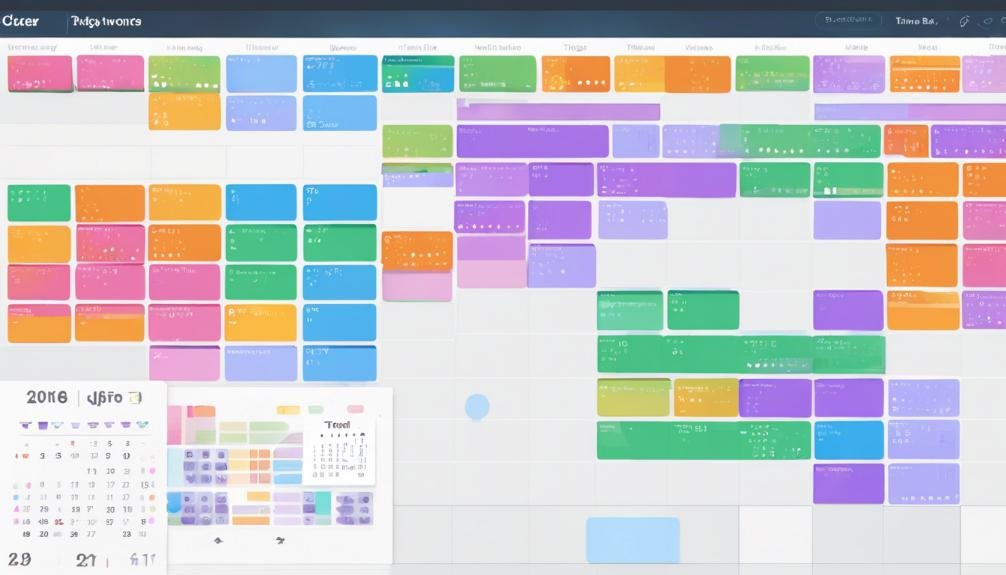AI for Staff Scheduling
When it comes to staff scheduling, AI offers a game-changing solution. Imagine having seamless shift assignments, efficient resource allocation, and real-time adjustments at your fingertips. The possibilities for enhancing workforce productivity and operational efficiency seem endless. But how does AI achieve all this without human intervention? Let's explore the intricacies of AI for staff scheduling and uncover its transformative impact on workforce management.
Key Takeaways
- AI optimizes shifts based on workload demand and employee availability.
- Machine learning predicts staffing needs accurately using historical data.
- Real-time considerations like skills and preferences enhance scheduling accuracy.
- Automated shift assignments reduce overstaffing and understaffing.
- Adaptive algorithms make real-time adjustments for workforce optimization.
Enhanced Scheduling Accuracy
By utilizing AI algorithms, staff scheduling systems can greatly enhance scheduling accuracy by optimizing shifts based on various factors such as workload demand and employee availability. Machine learning plays an important role in analyzing historical data to predict future staffing needs accurately.
Scheduling accuracy is notably improved when AI algorithms are employed to streamline the process by considering variables like employee skills, preferences, and availability in real-time.
Staffing optimization through AI algorithms guarantees that shifts are assigned efficiently, matching the right employees with the right tasks. By leveraging machine learning, these systems can adapt to changing circumstances, making adjustments on the fly to meet demand fluctuations.
The predictive capabilities of AI enable organizations to proactively address staffing needs, reducing the risk of under or overstaffing.
Automated Shift Assignments
Utilizing AI algorithms in staff scheduling systems enables the automation of shift assignments, ensuring efficient matching of employees with tasks based on various factors. Automated scheduling streamlines the process by analyzing employee availability, skills, preferences, and workload requirements to assign shifts effectively. This shift optimization leads to a balanced distribution of tasks among employees, reducing overstaffing or understaffing issues.
Automated scheduling systems consider various constraints such as labor laws, employee certifications, and business rules to generate ideal shift assignments. By incorporating historical data and real-time information, these systems adapt to changing demands and make adjustments in shift assignments promptly.
Through automated shift assignments, organizations can enhance productivity, employee satisfaction, and overall operational efficiency. By efficiently allocating resources and ensuring the right employees are assigned to the right tasks, businesses can minimize costs while maximizing output.
This innovative approach to staff scheduling not only saves time but also improves workforce management practices, leading to a more agile and responsive organization.
Optimal Resource Allocation
Effective resource allocation is essential for maximizing productivity and optimizing operational performance in staff scheduling systems. Resource optimization involves strategically assigning the right staff to the right shifts based on factors like skill sets, availability, and workload demands. By focusing on staffing allocation, organizations can enhance productivity and guarantee workforce efficiency.
In the domain of staff scheduling, ideal resource allocation plays a vital role in streamlining operations and meeting business objectives. It involves identifying peak hours, analyzing historical data, and predicting future demands to allocate resources effectively. By leveraging AI-driven algorithms, businesses can automate this process, leading to improved efficiency and cost savings.
Moreover, by continuously monitoring and adjusting staffing levels based on real-time data, organizations can address fluctuations in demand promptly. This proactive approach not only ensures efficient resource allocation but also enhances overall operational performance.
Through productivity enhancement strategies and smart resource management, businesses can achieve a competitive edge in today's dynamic market landscape.
Adaptive Scheduling Algorithms
Adaptive scheduling algorithms dynamically adjust staff assignments in real-time to optimize workforce efficiency and respond to changing operational needs. These algorithms leverage machine learning to analyze historical data and current demand, enabling advanced analytics for real-time decision-making.
By incorporating schedule optimization techniques, such as predictive modeling and pattern recognition, these algorithms can enhance workforce management by ensuring the right staff is assigned to the right tasks at the right times.
Through continuous monitoring and analysis of key performance indicators, adaptive scheduling algorithms enable organizations to proactively address fluctuations in workload and resource availability. This dynamic approach not only improves operational efficiency but also enhances employee satisfaction by aligning workload with individual skills and preferences.
Real-time Adjustments
To optimize workforce efficiency and respond to changing operational needs, real-time adjustments are crucial in ensuring that staff assignments align with current demand and performance indicators.
Real-time adjustments refer to the ability to make immediate changes to staff scheduling based on real-time data, allowing for dynamic scheduling that maximizes scheduling efficiency and workforce optimization.
Dynamic scheduling enables managers to adjust staff assignments on the go, responding to fluctuations in demand or unexpected changes in employee availability.
By incorporating real-time adjustments into staff scheduling processes, organizations can better match staffing levels with current needs, reducing overstaffing or understaffing situations. This agility in workforce management leads to improved operational efficiency, enhanced customer service, and increased employee satisfaction.
Incorporating real-time adjustments into staff scheduling software powered by AI algorithms allows for a proactive approach to workforce optimization.
Predictive Staffing Models
Utilizing advanced algorithms and historical data, predictive staffing models leverage AI technology to forecast future staffing needs based on demand patterns and performance metrics. These models rely on machine learning capabilities to analyze vast amounts of data and generate data-driven predictions.
By employing predictive analytics, businesses can optimize their staffing levels to meet anticipated requirements efficiently.
The cornerstone of predictive staffing models is their ability to adapt to changing circumstances in real-time. Through continuous analysis of incoming data, these models can adjust staffing predictions dynamically, ensuring that staffing levels align closely with demand fluctuations.
This agile approach to staffing optimization allows businesses to enhance operational efficiency and customer satisfaction.
Employee Preferences Integration
You can enhance staff scheduling efficiency by implementing a Preference Matching Algorithm that aligns employee preferences with shift requirements. This algorithm considers factors like preferred work times, days off, and specific shift types to optimize employee satisfaction.
Through the use of Automated Shift Assignment, the system can quickly generate schedules that meet both business needs and employee preferences.
Preference Matching Algorithm
The integration of employee preferences into the preference matching algorithm enhances the efficiency and satisfaction of staff scheduling processes. By incorporating shift matching and preference optimization, the algorithm can intelligently assign shifts that align with employees' desired schedules.
Shift matching guarantees that each employee is assigned to shifts that best fit their availability and preferences, reducing the likelihood of shift conflicts and improving overall scheduling accuracy.
Preference optimization takes into account various factors such as preferred shift times, days off, and workload preferences. This optimization process maximizes employee satisfaction by prioritizing their preferences while still meeting business needs.
Employees are more likely to be content with their schedules when they feel their preferences are considered and accommodated.
Automated Shift Assignment
Incorporating employee preferences into the automated shift assignment process streamlines scheduling efficiency by aligning shifts with individual staff members' desired schedules. By leveraging machine learning and AI algorithms, workforce optimization becomes more data-driven and accurate.
AI algorithms can analyze historical scheduling data, employee availability, and preferences to generate optimized shift assignments that meet both business needs and employee preferences.
This integration of employee preferences into automated shift assignment not only improves workforce management but also enhances employee satisfaction and retention. By considering factors like preferred shift times, days off, and workload preferences, AI-driven solutions can create schedules that better cater to individual employee needs.
Moreover, this approach fosters a more collaborative and flexible work environment by allowing staff members to have a say in their schedules.
Compliance Monitoring
Monitoring compliance with regulations and internal policies is a critical component of utilizing AI for staff scheduling efficiently. By implementing AI-powered solutions, organizations can guarantee adherence to both regulatory requirements and internal guidelines, safeguarding employee well-being and operational integrity.
AI for staff scheduling offers automated compliance monitoring features that continuously track and analyze scheduling decisions against regulatory requirements. This proactive approach helps identify and rectify any potential violations before they escalate, mitigating risks and ensuring a safe work environment for employees.
By integrating compliance monitoring capabilities into AI-driven scheduling systems, organizations can streamline regulatory compliance processes, saving time and resources while enhancing overall operational efficiency.
Furthermore, compliance monitoring tools embedded within AI solutions enable real-time oversight of scheduling practices, allowing for immediate adjustments to ensure alignment with both external regulations and internal policies. This proactive monitoring not only fosters compliance but also contributes to a more sustainable and ethical work environment, promoting employee well-being and organizational integrity.
Cost-effective Scheduling Solutions
To optimize your staff scheduling costs, consider implementing efficient shift allocation, automated time tracking systems, and efficient resource utilization strategies.
By utilizing AI-powered tools for scheduling, you can streamline the process of assigning shifts based on demand and staff availability, ultimately reducing labor costs.
Automated time tracking further enhances cost-effectiveness by ensuring accurate tracking of hours worked, minimizing errors, and preventing unnecessary labor expenses.
Efficient resource utilization involves strategically assigning tasks to maximize productivity and efficiency, contributing to overall cost savings in your staffing operations.
Efficient Shift Allocation
For optimizing shift allocation in staff scheduling, consider utilizing advanced AI algorithms to optimize workforce utilization and minimize costs. By incorporating AI-driven shift optimization solutions, you can enhance scheduling efficiency and boost overall workforce productivity. These algorithms analyze historical data, employee preferences, and business needs to create optimized shift schedules that meet both operational requirements and employee satisfaction.
AI algorithms can efficiently allocate shifts by taking into account factors such as employee availability, skill sets, and workload distribution. This guarantees that the right employees are scheduled at the right times, leading to improved productivity and reduced operational costs.
Moreover, by automating the shift allocation process, managers can save valuable time that would otherwise be spent on manual scheduling tasks.
Implementing AI for shift allocation not only streamlines the scheduling process but also contributes to a more satisfied and engaged workforce. Employees benefit from fairer and more predictable schedules, resulting in increased job satisfaction and reduced burnout.
Ultimately, leveraging AI for efficient shift allocation is a strategic investment that can drive operational excellence and employee well-being simultaneously.
Automated Time Tracking
Consider implementing automated time tracking as a cost-effective solution for optimizing staff scheduling efficiency. By utilizing productivity tracking tools, you can gain valuable insights into employee work patterns, helping you make data-driven decisions for scheduling optimization.
Automated time tracking systems provide a streamlined approach to time management, eliminating manual tracking errors and saving time for both managers and employees.
With automated time tracking, you can enhance workforce efficiency by accurately monitoring hours worked, breaks taken, and overall productivity levels. These insights enable you to identify underperforming areas and allocate resources more effectively. By analyzing real-time data, you can adjust schedules on-the-go, ensuring peak staffing levels at all times.
Incorporating automated time tracking into your scheduling processes not only improves workforce productivity but also enhances employee satisfaction by ensuring fair and transparent scheduling practices. Embracing this technology-driven approach to time management can lead to significant cost savings and increased operational efficiency in the long run.
Optimal Resource Utilization
Implementing AI-driven algorithms for staff scheduling can greatly enhance cost-effective resource utilization in your organization. By leveraging advanced technologies, such as machine learning and predictive analytics, you can achieve peak resource optimization and workforce efficiency.
AI-powered solutions can analyze historical data, current workloads, and employee skill sets to create staffing schedules that align with demand patterns, thereby maximizing staff utilization.
Staffing optimization through AI not only guarantees that you have the right number of employees scheduled at the right times but also helps in enhancing productivity through smarter allocation of tasks. By accurately matching staffing levels to workload requirements, you can reduce unnecessary labor costs while maintaining high service standards.
This approach leads to improved operational efficiency and customer satisfaction, as tasks are completed promptly and with the right skillset.
Improved Work-Life Balance
Enhancing work-life balance through AI-powered staff scheduling algorithms revolutionizes how organizations optimize employee productivity and well-being. By leveraging AI for scheduling, companies can facilitate remote work opportunities, promoting a better productivity balance for employees.
Through flexible scheduling, AI can help employees tailor their work hours to fit personal obligations, reducing stress and enhancing overall satisfaction.
AI algorithms can analyze various factors like peak productivity times and individual preferences to create personalized schedules that align with employees' wellness initiatives. This personalized approach not only enhances work-life balance but also fosters a more positive work environment where employees feel valued and supported in achieving their personal and professional goals.
Furthermore, AI can proactively identify potential scheduling conflicts and suggest adjustments in advance, reducing last-minute changes that can disrupt work-life balance.
Conclusion
To sum up, AI for staff scheduling is a game-changer in workforce management, streamlining processes and maximizing efficiency.
By harnessing the power of data-driven algorithms, organizations can optimize shift assignments, predict staffing needs, and guarantee efficient resource allocation.
This cutting-edge technology not only improves operational efficiency but also enhances employee satisfaction and productivity.
With AI at the helm, organizations can truly 'hit the ground running' towards a more efficient and productive future.







